From ancient times through today, African cultures have made beads of many different materials, including shells, seeds, bone, ivory, horn, clay, gourd, wood, rock crystal, iron, copper, brass, and gold. The widespread trade of colorful European glass seed beads, however, enabled African artisans to greatly expand traditional beadwork forms and designs, and they elevated this craft to a highly developed artform. Beadwork is used to make jewelry and to embellish clothing and other textiles, as well as to adorn sculpture, masks, everyday objects, and ritual paraphernalia. Because elaborate beadwork is not only beautiful but also very labor-intensive, beadwork is a symbol of wealth and high status in many African cultures.
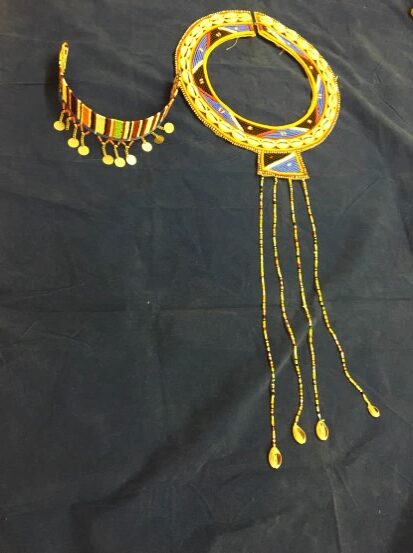
Maasai culture, southern Africa
20th century
Glass, tin, brass, cowrie shells, leather, and synthetic thread
L. 65 x W. 25.5 cm x H. 1 cm
BFPC collection #2012.52
Traditional Maasai collars and chokers were originally made using all-natural materials and with an emphasis on the traditional African triad of colors, which is red, white, and blue or black. As shown in this collar and choker, however, the influx of European glass trade beads has enabled the Maasai to expand their color palette to incorporate green and orange–which are considered to be typical today–as well as yellow and other bright hues. The collar is unusual in that it incorporates a row of cowrie shells, but it remains traditional because the Maasai are known to continuously develop their designs and often incorporate new and unusual materials in their work. Both men and women in Maasai culture wear beadwork, but this particular ensemble, with its squared extension and hanging strands, is known as a wedding necklace, and it is proudly worn by brides as a symbol of their married status. Researched by Amanda Horned
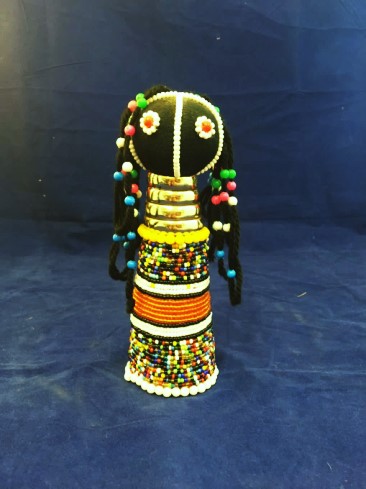
Ndebele culture, southern Africa
20th century
Glass, plastic, felt, synthetic yarn, synthetic cloth, and cotton thread
L. 5.8 cm x W. 5.8 cm x H. 19 cm
BFPC collection #2013.6a
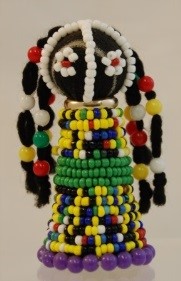
Ndebele culture, southern Africa
20th century
Glass, plastic, felt, synthetic yarn, synthetic cloth, and cotton thread
L. 4 cm x W. 5 cm x H. 8 cm
BFPC collection #2011.22
While these Ndebele figures were made of synthetic materials for the tourist-trade, they are strongly related to traditional figures made by different cultures of southern Africa. The simple, bifurcated head design and beaded eyes closely mimic the faces of traditional Ndebele dolls that were made by girls and given to boys whom they admired; the neck rings are reminiscent of Ndebele cultural tradition, as Ndebele women were once known for wearing metal rings to press down on the shoulders and collarbones to elongate the neck. Another form of traditional Ndebele figure that might have provided inspiration was a conical straw figure, wrapped in thread and beads, that mothers gave to their pubescent daughters to promote fertility; girls would fondle the dolls in hopes that they would have healthy children. Msinga and the Zulu peoples make similar fertility figures, with round, black heads, simply beaded faces, beaded-strand hairstyles, and cone-shaped, beaded bodies. With the arrival of a strong tourist trade in southern Africa, indigenous women began making and selling their traditional figures. As the figures became increasingly popular, however, they developed simpler versions such as these figures, which are made with less-expensive, synthetic materials and are much faster and easier to produce. Researched by Amanda Horned and Rebecca Warden
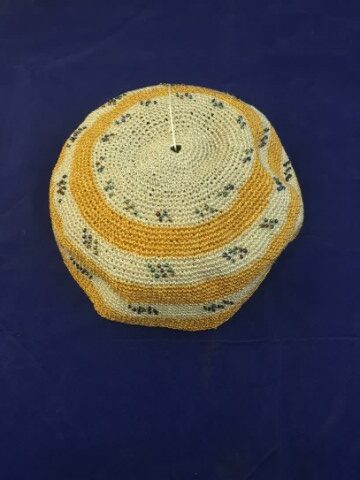
Yoruba culture
20th century
Metallic thread and glass beads, L. 8.1 cm x W. 16.5 cm x H. 16.5 cm
BFPC collection #2010.006
Both Christian European cultures and Islam have made an impact on the traditional Yoruba cultures of Nigeria, particularly in their creation of beadwork headgear. The import of European glass trade beads has allowed for the development of elaborate, labor-intensive forms of beadwork that are a symbol of high status and royalty among the Yoruba. Among other items, the Yoruba developed ornate beadwork royal crowns in traditional, conical forms as well as in the form of European crowns with cross motifs and in the form of British army officer hats. The adoption of Islam by many Yoruba has led to further developments in woven beadwork headgear, as illustrated by this gold and silver skullcap. While the form of the skullcap is Islamic, the colors reflect Yoruba beliefs. For the Yoruba, silver represents coolness, age, and wisdom, while gold represents warmth; the accents of dark, iridescent beads, meanwhile, represent the bridging of these extreme temperatures. Researched by Amanda Horned
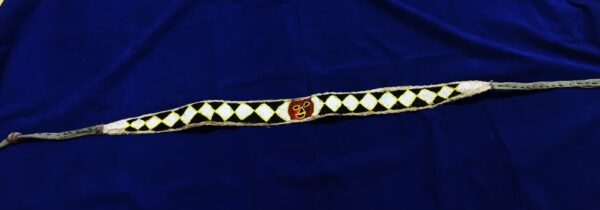
Yoruba culture
20th century
Glass beads, leather, cotton cloth, and cotton thread
L. 1.36 m x W. x 5 cm H. x 5 mm
BFPC collection #2013.7
For the Yoruba, beadwork denotes high status and royal favor, as the reigning king controls who may have beadwork. Diviners, specialists who are in contact with the supernatural spirit world, are high-status individuals who are often granted possession of different types of beadwork, and they often have beaded paraphernalia that directly relates to their professional role, such as diviner’s bags, dance panels for rituals, and articles of clothing.
Clearly identifying this belt as a garment belonging to a diviner is the red face that is prominently beaded into the center. A hallmark of Yoruba diviner adornments and accouterments, this face represents the “inner head,” the spiritual power and destiny of the person who owns the object. This destiny is believed to be chosen by the person before s/he leaves the spirit world, but it is often forgotten upon entering the living realm. The yellow accent color on the belt connotes wisdom and is also frequently found on diviners’ paraphernalia. Researched by Amanda Horned and Cortney Metzger
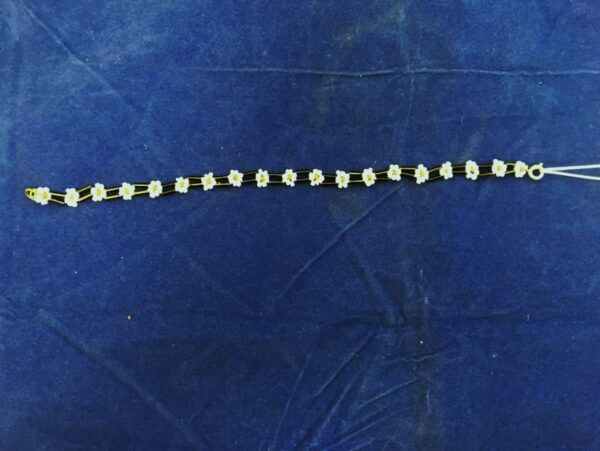
Zulu culture
20th century
Glass, plastic, synthetic thread, and metal clasps
L. 23.6 cm x W. 6 mm x H. x 1 mm
BFPC collection #2005.001
When Zulu traditional beadwork became popular in the tourist trade, the Zulu were quick to develop suitable elaborate pieces for collectors as well as smaller, simpler items that would sell quickly, like this beaded ankle bracelet. Such pieces draw upon traditional knowledge of techniques and designs, but they are also relatively simple and quick to make and they conserve materials. Today these items are crafted at home as well as in public workshops, where knowledge is passed on to others in the community, and the production of these items provides much-needed income. Artisans are encouraged to use traditional motifs as well as to add personal flourishes to create individuality; this bracelet may use a floral motif that was adopted from European designs, but the flowers also closely resemble the flower-like eyes on Zulu and Ndebele figures. Researched by Amanda Horned
For more information, you may contact the researcher(s) noted in the title of this exhibit entry, or Dr. Billie Follensbee, the professor of the course, at BillieFollensbee@MissouriState.edu
